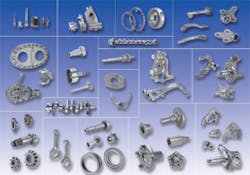Germany recovered particularly well from the 2008 - 2009 economic crisis. Just like many other industrial segments that played a role in this development, the German forging sector is characterized by many small to mediumsized companies. What are the drivers behind this success story?
“In the current situation, with globally mounting economic and political difficulties, Germany is a valuable anchor of stability largely thanks to the manufacturing industry on which its economy is traditionally based,” stated Dr. Theodor L. Tutmann, CEO of the German Forging Industry Assn..
German industry relies on automaking, machine and plant building, the energy sector, chemicals and pharmaceuticals, and steelmaking, as well as metal and plastics parts manufacturing. German companies develop and manufacture products so well recognized for their quality that they can be globally competitive, and the German forging industry is no exception. Especially for applications where sturdiness and reliability have to be secured, nothing matches forged components and assemblies.
“This success is also attributable to a new approach the forgers adopted with respect to their role in the process chain,” Dr. Tutmann added. Thanks to considerable investment in process simulation, plant technology, and materials, modern forged parts are high-tech products in their own right. Today, technologies based on the computer-assisted design of complex forging processes are just as commonplace as multipleaction tools that increasingly reduce the number of forging steps required to produce a given part. Many cutting-edge products would not reach their current performance levels without modern high-strength, highly precise forged parts. This includes carriages, crankshafts, and gearboxes for cars, as well as turbine blades for jet engines. Moreover, forging has expanded beyond these traditional sectors to establish itself as a supplier of up-and-coming applications such as e-mobility, renewable energy generation or medical technologies. Various high-end materials like aluminum, titanium, nickel or cobalt alloys are now processed just as easily as steel. “In the same context, our industry has consistently expanded its share of addedvalue operations along the production process chain,” Dr. Tutmann explained.
He added that innovation has to be promoted simultaneously at every step of the process chain. Production processes of the future will result in lightweight structural parts such as hollow shafts or gear wheels, parts shaped by partial forming, or multi-material hybrids. Finding new solutions requires the cooperation of all parties contributing to the process chain, with special emphasis on forging process knowhow. Forging companies thus act as development partners, working with customers and raw material suppliers alike.
“In this context, the German Forging Industry Assn., with its more than 120 member companies, defines itself not only as a catalyst, but beyond that as a driving force in its own right for such cooperation,” Dr. Tutmann explained. Fostering the collaboration between its mostly small to medium-sized entities thus ranks high on the agenda of the Association. Another focus is promoting R&D for new or enhanced materials. Improved forging materials proved to be a major factor boosting recovery after the crisis, and future objectives include opening up new markets and application fields for forged parts within, and beyond, the automotive sector.
“Harnessing science for the benefit of our sector is a vital component of our task portfolio,” said Dr. Tutmann. This mainly involves financing and overseeing R&D projects at universities and research institutes. About 15 research partners specializing in forging benefit from these sponsoring activities, and additional support is directed toward institutions performing materials research. In the broader context of computer-assisted design of parts and processes, special attention is paid to computerized methods helping to simulate and analyze all aspects of the forging process in advance.
— Reported by Klaus Vollrath
